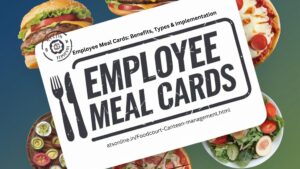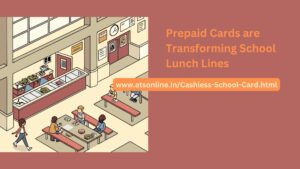“Cashless Canteen: Unlocking the Power of Prepaid Cards for Streamlined Management Systems.”
Introduction
Cashless Canteen is a revolutionary new system that is revolutionizing the way canteens are managed. It is a prepaid card system that streamlines the management of school canteens, making it easier for both students and staff to purchase food and drinks. The system is designed to reduce the amount of time spent on managing the canteen, as well as reducing the amount of cash that needs to be handled.
It also provides a secure and convenient way for students to purchase food and drinks, as well as providing a way for parents to monitor their children’s spending. Cashless Canteen is quickly becoming the preferred choice for school canteens, as it provides a more efficient and secure way to manage the canteen.
The Benefits of a Cashless Canteen: How Prepaid Cards Can Improve Efficiency and Reduce Costs
The introduction of cashless canteen systems has revolutionized the way in which canteens operate. By replacing traditional cash transactions with prepaid cards, canteens can improve efficiency, reduce costs, and provide a more secure and convenient payment system for customers. This article will discuss the benefits of a cashless canteen system and how prepaid cards can help to improve efficiency and reduce costs.
One of the main benefits of a cashless canteen system is improved efficiency. By eliminating the need for cash transactions, canteens can reduce the amount of time spent on processing payments and handling cash. This can help to speed up the checkout process, allowing customers to get their food faster and reducing the amount of time spent in line. Additionally, cashless systems can help to reduce the amount of time spent counting and reconciling cash at the end of the day.
Another benefit of a cashless canteen system is reduced costs. By eliminating the need for cash transactions, canteens can save money on the cost of handling and processing cash. Additionally, prepaid cards can help to reduce the amount of money lost due to theft or fraud. By providing customers with a secure and convenient payment system, canteens can reduce the risk of theft and fraud, resulting in lower costs.
Finally, prepaid cards can provide customers with a more secure and convenient payment system. By eliminating the need for cash transactions, customers can feel more secure when making purchases. Additionally, prepaid cards can provide customers with the ability to track their spending and manage their budget more effectively.
In conclusion, cashless canteen systems can provide a number of benefits to canteens, including improved efficiency, reduced costs, and a more secure and convenient payment system for customers. By replacing traditional cash transactions with prepaid cards, canteens can improve efficiency, reduce costs, and provide customers with a secure and convenient payment system.
How to Implement a Cashless Canteen System: A Step-by-Step Guide
Introduction
A cashless canteen system is an efficient and secure way to manage the payment of food and drinks in a school or workplace canteen. It eliminates the need for cash transactions, reducing the risk of theft and providing a more convenient way for customers to pay. This guide will provide a step-by-step guide on how to implement a cashless canteen system.
Step 1: Choose a Payment System
The first step in implementing a cashless canteen system is to choose a payment system. There are a variety of payment systems available, including contactless cards, mobile payments, and online payments. Consider the needs of your canteen and the preferences of your customers when selecting a payment system.
Step 2: Set Up the Payment System
Once you have chosen a payment system, you will need to set it up. This may involve registering with the payment provider, setting up an account, and linking it to your canteen’s bank account. You may also need to purchase any necessary hardware, such as card readers or mobile payment terminals.
Step 3: Train Staff
Your staff will need to be trained on how to use the payment system. This may involve providing them with instructions on how to process payments, as well as any safety procedures that need to be followed.
Step 4: Promote the System
Once the payment system is set up and staff are trained, you will need to promote the system to your customers. This may involve displaying posters or flyers in the canteen, as well as sending out emails or text messages to customers.
Step 5: Monitor Usage
Finally, you will need to monitor the usage of the payment system. This may involve tracking sales data, as well as customer feedback. This will help you identify any issues with the system and make any necessary changes.
Conclusion
Implementing a cashless canteen system can provide a more efficient and secure way to manage payments in a school or workplace canteen. By following the steps outlined in this guide, you can ensure that the system is set up correctly and that customers are aware of how to use it.
The Pros and Cons of Cashless Canteens: What to Consider Before Making the Switch
Cashless canteens are becoming increasingly popular in schools, universities, and workplaces. While they offer a number of advantages, there are also some potential drawbacks to consider before making the switch. This article will outline the pros and cons of cashless canteens, so that you can make an informed decision about whether or not to implement one.
The Pros
One of the main advantages of cashless canteens is that they are more efficient than traditional canteens. By eliminating the need for cash, they reduce the amount of time it takes to make a purchase, allowing customers to get their food faster. Additionally, cashless canteens are more secure than traditional canteens, as they reduce the risk of theft and fraud.
Another benefit of cashless canteens is that they can help to reduce waste. By eliminating the need for paper money and coins, they reduce the amount of paper and plastic waste generated by the canteen. Additionally, cashless canteens can help to reduce food waste, as customers can easily track their purchases and monitor their spending.
The Cons
One of the potential drawbacks of cashless canteens is that they require an initial investment. In order to implement a cashless system, you will need to purchase the necessary equipment and software, which can be costly. Additionally, you may need to hire additional staff to manage the system, which can also add to the cost.
Another potential downside of cashless canteens is that they can be difficult to use for customers who are unfamiliar with the technology. This can be especially true for elderly customers, who may not be comfortable using a card or smartphone to make a purchase. Additionally, cashless canteens may not be suitable for customers who do not have access to a bank account or credit card.
Conclusion
Cashless canteens offer a number of advantages, including increased efficiency, security, and reduced waste. However, they also require an initial investment and may not be suitable for all customers. Before making the switch, it is important to consider the pros and cons of cashless canteens and decide if they are right for your canteen.
The Future of Cashless Canteens: Exploring the Latest Technologies and Trends
The cashless canteen is a growing trend in the food service industry, and it is becoming increasingly popular in schools, universities, and workplaces. As technology advances, so too does the potential for cashless canteens to become more efficient and secure. This article will explore the latest technologies and trends in cashless canteens, and how they can benefit both customers and businesses.
One of the most popular technologies used in cashless canteens is the use of contactless payment systems. This technology allows customers to pay for their purchases with a simple tap of their card or mobile device. This eliminates the need for customers to carry cash or wait in line to pay, making the process much faster and more convenient. Additionally, contactless payment systems are secure and reliable, reducing the risk of fraud or theft.
Another technology that is becoming increasingly popular in cashless canteens is the use of mobile apps. These apps allow customers to order and pay for their food in advance, eliminating the need to wait in line. Additionally, many apps offer loyalty programs and discounts, making them an attractive option for customers.
Finally, the use of artificial intelligence (AI) is becoming increasingly popular in cashless canteens. AI can be used to automate the ordering process, allowing customers to order their food quickly and easily. Additionally, AI can be used to analyze customer data and provide personalized recommendations, helping to increase customer satisfaction.
Overall, cashless canteens are becoming increasingly popular, and the latest technologies and trends are making them more efficient and secure. Contactless payment systems, mobile apps, and AI are all helping to make cashless canteens more convenient and attractive to customers. As technology continues to advance, cashless canteens will become even more popular, and businesses should take advantage of the latest technologies and trends to ensure their success.
Best Practices for Managing a Cashless Canteen: Tips for Streamlining Systems and Ensuring Security
1. Establish Clear Policies: Establish clear policies for the cashless canteen system, including rules for payment, refunds, and other transactions. Make sure all staff and customers are aware of these policies.
2. Utilize Technology: Utilize technology to streamline the cashless canteen system. Consider using a mobile app or online payment system to make transactions easier and more secure.
3. Train Staff: Train staff on the cashless canteen system and how to use it. Make sure they understand the policies and procedures for handling payments and refunds.
4. Monitor Transactions: Monitor transactions closely to ensure accuracy and security. Consider using a third-party payment processor to help with this.
5. Secure Data: Ensure that all customer data is secure and protected. Use encryption and other security measures to protect customer information.
6. Offer Support: Offer customer support for any issues that may arise with the cashless canteen system. Make sure customers know who to contact if they have any questions or concerns.
7. Regularly Audit: Regularly audit the cashless canteen system to ensure accuracy and security. Make sure all transactions are properly recorded and that all customer data is secure.
8. Educate Customers: Educate customers on the cashless canteen system and how to use it. Make sure they understand the policies and procedures for making payments and refunds.
By following these best practices, you can ensure that your cashless canteen system is secure, efficient, and easy to use. With the right policies and procedures in place, you can streamline your system and ensure that customers have a positive experience.
Conclusion
Cashless Canteen prepaid cards are a great way to streamline management systems in schools and other organizations. They provide a secure and efficient way to manage payments, reduce the amount of time spent on administrative tasks, and provide a convenient way for students and staff to purchase meals. The cards also provide an additional layer of security, as they can be used to track purchases and monitor spending. Overall, cashless canteen prepaid cards are an effective and efficient way to manage payments and streamline management systems.
Make your canteen management system more efficient and streamlined with prepaid cards! With cashless canteen, you can easily manage your canteen operations and reduce the hassle of handling cash. Click here to learn more about how prepaid cards can help streamline your canteen management system.






Now all became clear, many thanks for the information. You have very much helped me.